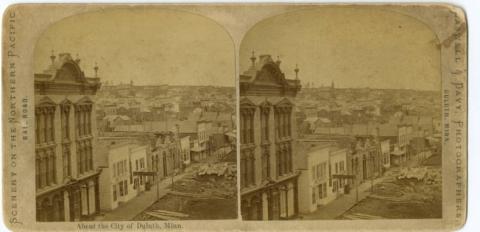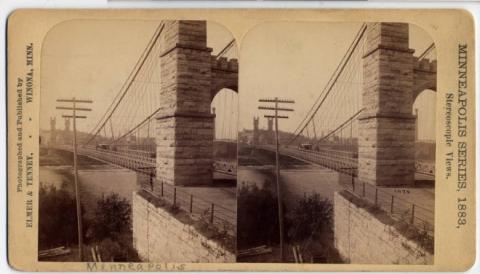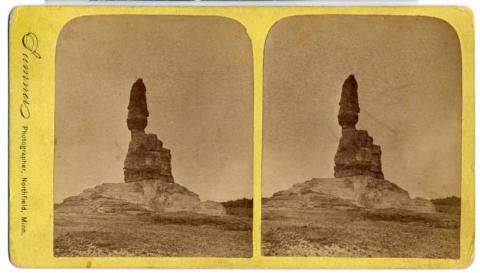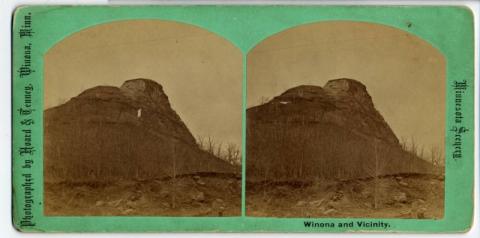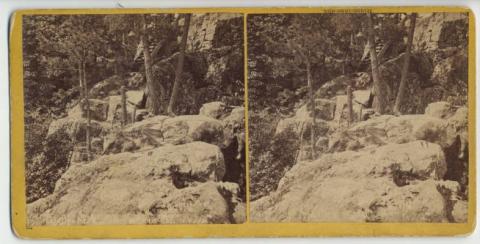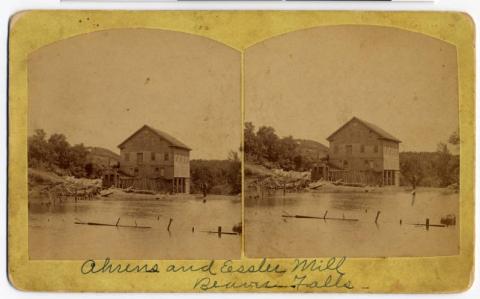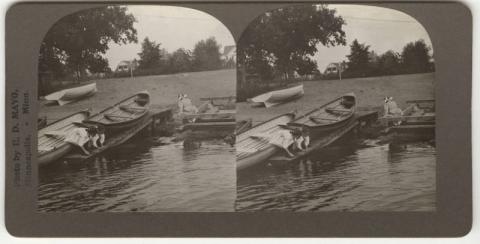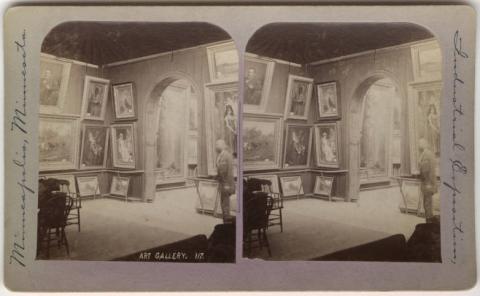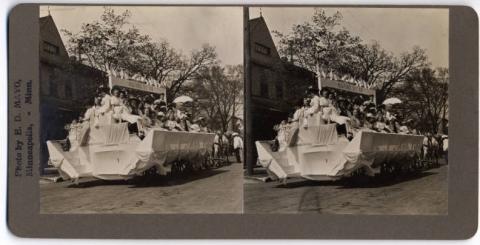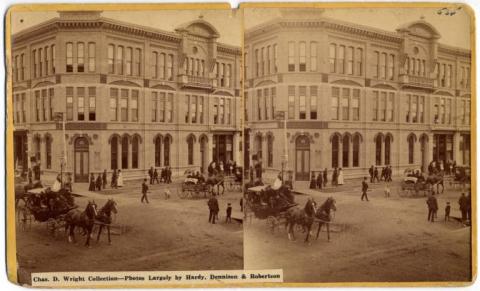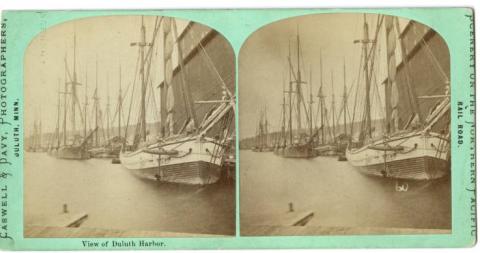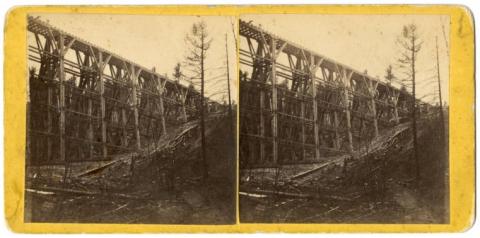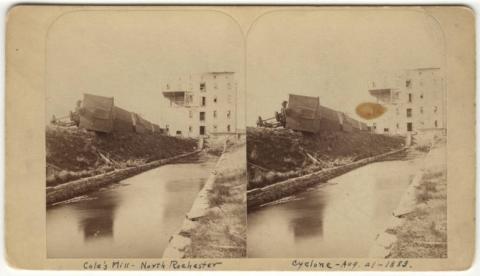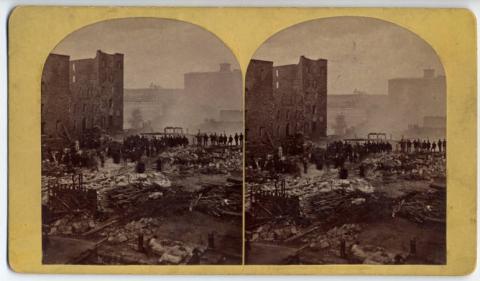Primary Source Set
by Greta Bahnemann, Metadata Librarian, Minnesota Digital Library, Minitex
Arts and Literature Format Highlight
Stereographic images are frequently found in historic collections in museums and libraries. They are easily recognized with their side by side images, but not everyone knows their history. Stereographs are made up of two nearly identical images mounted onto cardstock. This combined image is then viewed through a stereoscope, and the user perceives the two separate images as a single three-dimensional image. The individual cards could include an embossed label with the photographer's name and address as well as a descriptive title.
Stereographs were first made in the 1850s, but they were most popular between 1870 and 1920. Stereographic images had widespread interest as both the viewers and the images were relatively inexpensive. Images could be purchased singly or in sets and were easily available to the emerging middle class. These images were distributed to the public via direct sales by door-to-door salesmen, mail order, and in photography studios. As they became more popular, the images were collected, traded, organized, shared, and very often displayed in many middle-class homes.
Typical subjects for stereographic images included landscapes and natural features, architecture and city views, and fine art, as well as parades and celebrations. Stereograph images could also depict natural disasters and accidents. By the 1920s stereograph images were eclipsed by the emerging world of motion pictures, but the idea of a 3D image lived on in Tru-Vue stereoscopic filmstrips and the children's View-Master.
Discussion Questions & Activities
- Read the article on making your own stereograph camera by George Bandy. Make a list of the kind of things that would lend themselves to a stereograph image. Can you adapt his instructions to work with digital cameras today?
- Why were stereographs so popular? Why do you think stereograph images lost popularity?
- Stereograph images allowed people to "travel the world" from the comfort of their own homes. Images of natural wonders, great cities, and far off places could be viewed in a single evening. How do we use technology like the internet in similar ways today?
- Examine a stereograph image closely and determine where the side-by-side images are the same and different. What is the purpose of these variations?
- Compare and contrast two different stereograph images. How are they similar? How are they different? Why?
- Look at the last row of images. They show tornado damage in Rochester, a fire in Stillwater, and a mill explosion in Minneapolis. Why do you think natural disasters and accidents were captured as stereograph images?
eLibrary Minnesota Resources (for Minnesota residents)
Batkins, Donald L. "DOUBLE VISION Stereographs in Michigan." Michigan History Magazine, vol. 105, no. 2, Mar.-Apr. 2020, pp. 14+. Gale In Context: High School. Accessed 16 Mar. 2023.
"History of photography." Britannica Academic, Encyclopædia Britannica, 10 Jan. 2023. Accessed 16 Mar. 2023.
Murphy, Michael J. "Stereoscopes." St. James Encyclopedia of Popular Culture Online, Gale, 2013. Gale In Context: High School. Accessed 9 Oct. 2025.
Rubin, Cynthia Elyce. “DOUBLE VISION: O.S. LEELAND’S STEREOGRAPHS Norwegian Independence Day Fargo 17May 1904.” North Dakota Horizons, vol. 41, no. 2, Apr. 2011, pp. 14–17. EBSCOhost. Accessed 9 Oct. 2025.
Schemmer, Clint. “Nation’s Library Gains ‘Phenomenal’ Civil War Stereograph Collection.” Free Lance-Star, The (Fredericksburg, VA), 29 Mar. 2015. EBSCOhost. Accessed 9 Oct. 2025.
"Stereoscope." World of Invention, Gale, 2006. Gale In Context: High School. Accessed 9 Oct. 2025.
"Technology of photography." Britannica School, Encyclopædia Britannica, 17 Aug. 2023. Accessed 9 Oct. 2025.
Thompson, Clive. “The Illusion of Reality: The Shocking Power of Virtual Reality Was All the Buzz Once before--about 150 Years Ago.” Smithsonian, vol. 48, no. 6, Oct. 2017, pp. 18–88. EBSCOhost. Accessed 16 Mar. 2023.
Additional Resources for Research
Bandy, George. "Easy as 1, 2, 3D: make a stereograph, using two cameras to create cool 3D snapshots." Boys' Life, vol. 98, no. 10, Oct. 2008, pp. 58+. Accessed 2 Mar. 2023.
“Stereograph Cards - Background and Scope.” Library of Congress. Accessed 2 Mar. 2023.
"Stereographs.” American Antiquarian Society. Accessed 2 Mar. 2023.
Thompson, Clive. “Stereographs Were the Original Virtual Reality.” Smithsonian Magazine, Smithsonian Institution, Oct. 2017. Accessed 2 Mar. 2023.
Published onLast Updated on
